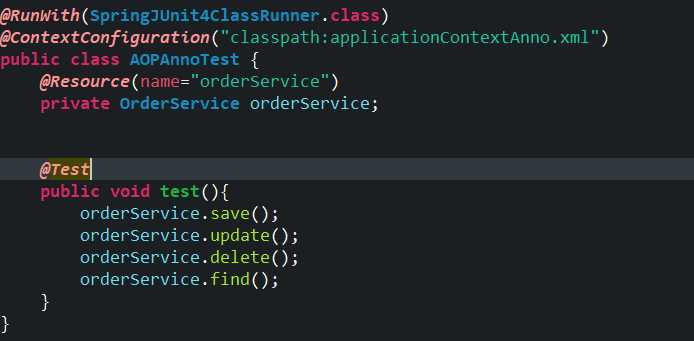标签:逻辑 expr except work dao ret 接口 入门 效率
在软件业,AOP为Aspect Oriented Programming的缩写,意为:面向切面编程,通过预编译方式和运行期动态代理实现程序功能的统一维护的一种技术。AOP是OOP的延续,是软件开发中的一个热点,也是Spring框架中的一个重要内容,是函数式编程的一种衍生范型。利用AOP可以对业务逻辑的各个部分进行隔离,从而使得业务逻辑各部分之间的耦合度降低,提高程序的可重用性,同时提高了开发的效率。 --来自百度
Proxy.newProxyInstance(xx,xx,xx) 生成代理对象,现在Spring能够帮我们生成代理对象spring 的AOP 是使用动态代理实现的
两种动态代理方式:
JDK 提供的动态代理
cglib动态代理
第三方代理技术,cglib代理,可以对任何类实现代理,代理的原理是对目标对象进行继承(生成子类)代理。如果目标对象被final修饰,该类无法被cglib代理。
// 使用cglib来动态代理
public class CglibProxy {
private CustomerDao customerDao;
public CglibProxy(CustomerDao customerDao) {
this.customerDao = customerDao;
}
public CustomerDao crateProxy(){
Enhancer enhancer = new Enhancer();
enhancer.setSuperclass(customerDao.getClass());
enhancer.setCallback(new MethodInterceptor() {
@Override
public Object intercept(Object proxy, Method method, Object[] args, MethodProxy methodProxy) throws Throwable {
if("save".equals(method.getName())){
// 增强
System.out.println("权限验证");
return methodProxy.invokeSuper(proxy, args);
}
return methodProxy.invokeSuper(proxy, args);
}
});
// 返回代理的对象
return (CustomerDao)enhancer.create();
}
}测试
@Test
public void test(){
CustomerDao customerDao = new CustomerDao();
CustomerDao proxyCustomer = new CglibProxy(customerDao).crateProxy();
proxyCustomer.save();
proxyCustomer.delete();
proxyCustomer.update();
proxyCustomer.find();
}输出
权限验证
CustomerDao.save()
CustomerDao.delete()
CustomerDao.update()
CustomerDao.find()
引入配置文件
<?xml version="1.0" encoding="UTF-8"?>
<beans xmlns="http://www.springframework.org/schema/beans"
xmlns:xsi="http://www.w3.org/2001/XMLSchema-instance"
xmlns:aop="http://www.springframework.org/schema/aop" xsi:schemaLocation="
http://www.springframework.org/schema/beans http://www.springframework.org/schema/beans/spring-beans.xsd
http://www.springframework.org/schema/aop http://www.springframework.org/schema/aop/spring-aop.xsd"> <!-- bean definitions here -->
</beans>准备目标类
public class UserServiceImpl implements UserService {
@Override
public void save() {
System.out.println("UserServiceImpl.save()");
}
@Override
public void find() {
System.out.println("UserServiceImpl.find()");
}
@Override
public void update() {
System.out.println("UserServiceImpl.update()");
}
@Override
public void delete() {
System.out.println("UserServiceImpl.delete()");
}
}配置文件中配置目标对象(bean)
<bean name="userService" class="com.ranger.apectjAOP.UserServiceImpl"></bean>配置文件中配置切面对象
<!-- 切面对象配置 -->
<bean name="myAspectXML" class="com.ranger.apectjAOP.MyAspectXML"></bean>完成目标对象的代理
<!-- 完成对目标对象的代理 -->
<aop:config>
<aop:pointcut expression="execution(* com.ranger.apectjAOP.UserServiceImpl.save(..))" id="pointcut1"/>
<aop:aspect ref="myAspectXML">
<aop:before method="checkPriv" pointcut-ref="pointcut1"/>
</aop:aspect>
</aop:config>测试
@Test
public void test1(){
ApplicationContext applicationContext = new ClassPathXmlApplicationContext("applicationContext.xml");
UserService userService = (UserService) applicationContext.getBean("userService");
userService.save();
}
输出:
权限验证
UserServiceImpl.save()
<aop:before method="checkPriv" pointcut-ref="pointcut1"/> <!-- application.xml中配置-->切面类
public class MyAspectXML {
public void checkPriv(JoinPoint joinPoint){
System.out.println("权限验证"+joinPoint);
}
public void afterReturning(Object result){
System.out.println("日志记录........"+result);
}
// 环绕通知
public Object around(ProceedingJoinPoint pjp) throws Throwable {
System.out.println("这是环绕通知之前的部分!");
Object proceed = pjp.proceed();
System.out.println("这是环绕通知之后的部分!");
return proceed; // 返回值
}
// 最终通知:出现异常也会调用
public void after() {
System.out.println("这是后置通知(出现异常也会调用)");
}
public void afterException() {
System.out.println("异常出现了!");
}
}
切入点的配置
<aop:config>
<!-- 切入点 -->
<aop:pointcut expression="execution(* com.ranger.apectjAOP.UserServiceImpl.save(..))" id="pointcut1"/>
<aop:pointcut expression="execution(* com.ranger.apectjAOP.UserServiceImpl.delete(..))" id="pointcut2"/>
<aop:pointcut expression="execution(* com.ranger.apectjAOP.UserServiceImpl.update(..))" id="pointcut3"/>
<aop:pointcut expression="execution(* com.ranger.apectjAOP.UserServiceImpl.find(..))" id="pointcut4"/>
</aop:config><!--returning 属性设置连接点的返回值,这个返回值可以在通知中的方法参数中获取 -->
<aop:after-returning method="afterReturning" pointcut-ref="pointcut2" returning="result"/><aop:around method="around" pointcut-ref="pointcut3" /><aop:after-throwing method="afterException" pointcut-ref="pointcut4"/><aop:after method="after" pointcut-ref="pointcut4"/>以上配置可以使用注解开发
public void com.ranger.spring.userDao.save(..)* *.*.*Dao.save(..)任意包下的以Dao结尾的save方法* com.ranger.spring.userDao+.save(..)com.ranger.spring包下userDao类及其子类的save方法* com.ranger.spring..*.*(..) com.ranger.spring包及其子包下的所有类的所用方法




标签:逻辑 expr except work dao ret 接口 入门 效率
原文地址:https://www.cnblogs.com/watertreestar/p/11740758.html